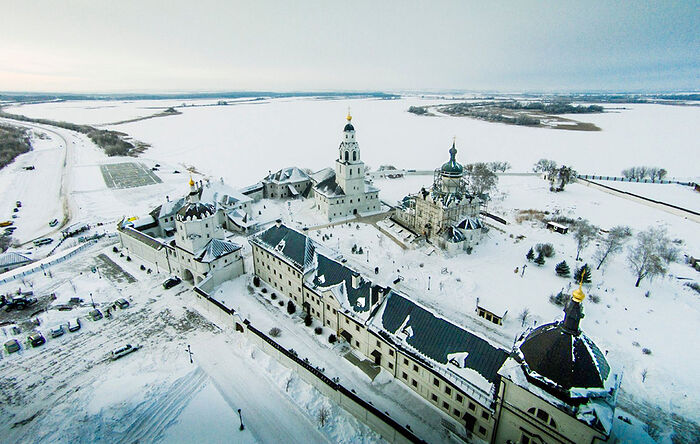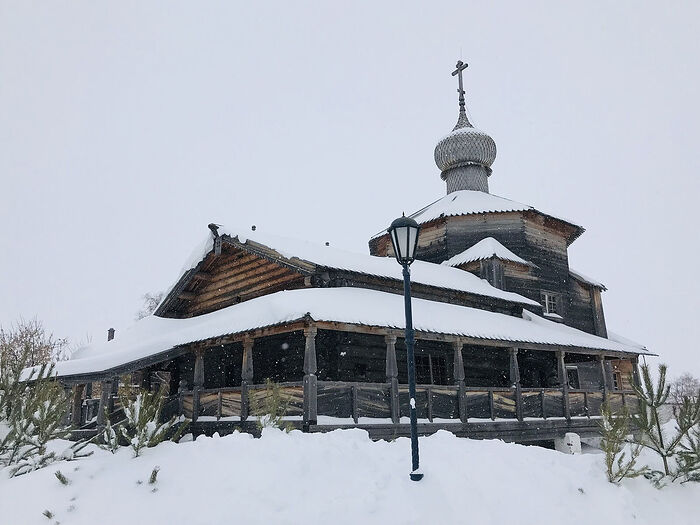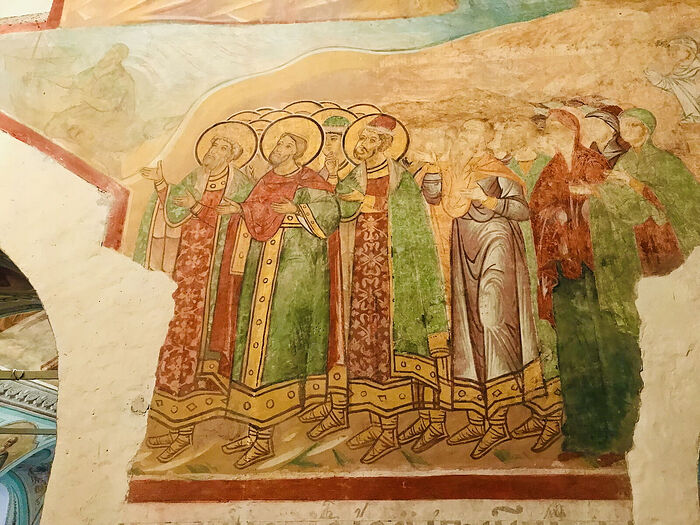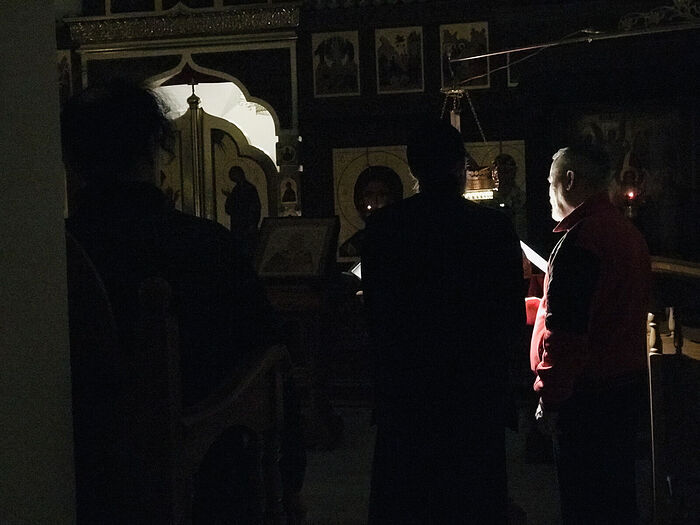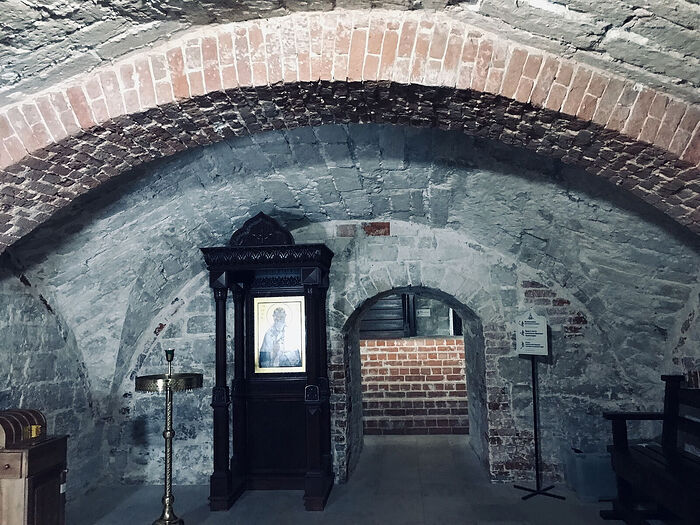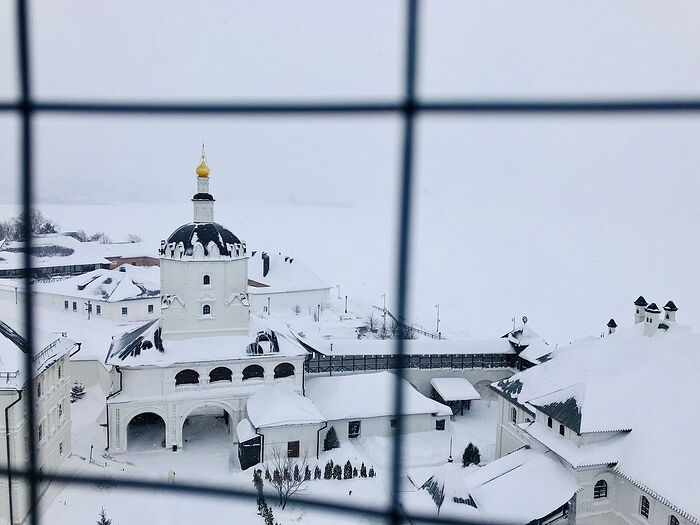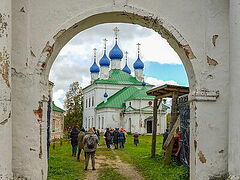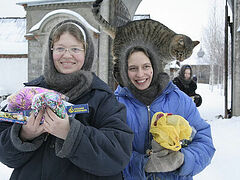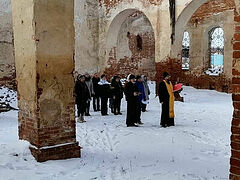Once you get there, at the confluence of Volga and the Sviyaga River, you immediately succumb to the power of the ever-present wind and lose any hope of finding refuge from it. It is everywhere and—it is far too feisty. It lunges at the cast iron lampposts In an attempt to bend them; it also bangs against the heavy-duty monastery gates, scratches the plastered church walls, or dolefully joins the monks singing in the choir. The wind even blows on the surface of a pot with stewed fruit, and mere moments later, newly refreshed, tries to get the bell tongues in motion—and it works! Not to mention playing a game of snow checkers, drifting them from one roof to another. Sometimes, the wind gets so busy playing that it dumps an impassable “checker” in the middle of the road that connects the island and the mainland. It leaves the islanders without food, the museums without the museum workers, and the monastery without the pilgrims. It is Sviyazhsk, and I visited it in February when the wind was the rightful owner of the ancient whitewashed walls.
Chief fellow traveller and friend
“The wind is our chief fellow traveller and friend. We can’t win it over, so we have to befriend it,” explains Hyeromonk Barsanuphius (Lepekha) of the Sviyazhsk Dormition of the Mother of God Monastery. Fr. Barsanuphius was transferred here six years ago from Optina Monastery—to strengthen the monastery life. He says that the first six months were primarily used to learn how to deal with the local weather. It’s all good now—batiushka steadily walks along the snow-bound road without turning aside and away from the blizzard. He has become a local now. We are making our way towards the heart of Sviyazhsk, where everything began.
On our way there, we try to contemplate the beauty as we shout above the howling wind. It is quite hard to think about anything else here, in a place wedged between the sky and water. And then again, if we agree that thoughts can alter the universe, it will turn out that Sviyazhsk was inhabited by many people who had beautiful thoughts. Because how else can we explain the appearance of these architectural and artistic wonders. Moreover, they were built and painted over a span of a few centuries, made of white stone, red brick, or wood…
Sviyazhsk was inhabited by many people who had beautiful thoughts. Because how else can we explain the appearance of these architectural and artistic wonders
“But what strikes me is the combination of beauty and sorrowfulness of this place,” Fr. Barsanuphius suddenly says, and I understand that he is verbalizing now what he has been pondering for a long while. This place has seen many people die during the twentieth century alone, when the island was the site of a correctional facility at first and later a concentration camp.
Fr. Barsanuphius makes a few more steps under the falling snow and then finally utters what made him start this conversation: “Sorrow is surely felt here, but the Lord somehow covers it all with beauty.”
We get closer to the place, the reason for the trip we had to endure in the middle of a blizzard; a whirlwind of fine sparkling needles lashes over our faces, our feet drown in a thick and squeaky soggy mass, and a low-lying blue sky is about to swallow up the top of the tallest bell tower on the island that reaches forty three meters in height. I keep thinking: what if the wind is trying so hard that it can sweep the sorrowfulness away from here? But we can’t give history an airing, neither can the most powerful snowstorm make it white.
The oldest wooden church
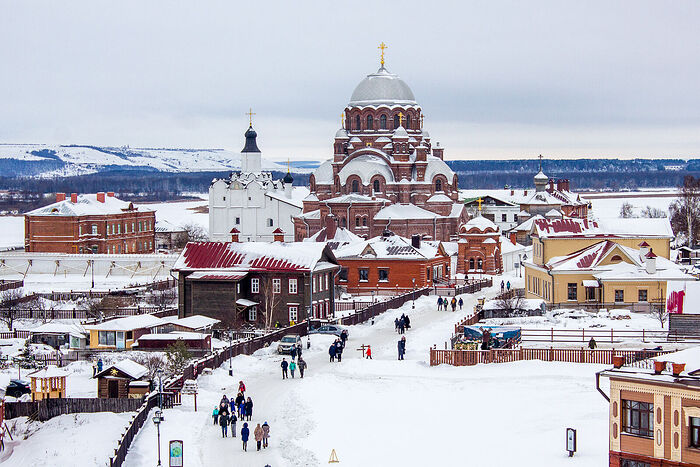 St. John the Forerunner Sviyazhsk monastery
St. John the Forerunner Sviyazhsk monastery
We approach the holy gates of the St. John the Forerunner monastery, with the wooden Trinity Church standing right behind it. It is the oldest structure in Sviyazhsk and in the entire Povolzhye region dating back to the sixteenth century. The church looks as if it were a ship that sailed up here from the Holy Rus. And this is only partly metaphoric. It was built by the monks from the Holy Trinity St.-Sergius Lavra who came to the island together with the troops of Ivan the Terrible. Basically, had it not been for the Tsar and his geopolitical goals, there wouldn’t be any Sviyazhsk today. The Tsar chose the island (to be correct, it was a peninsula then, as it was submerged from one side as late as the twentieth century) as a good starting point for his conquest of Kazan. This was also when he decided: Once Kazan falls, Sviyazhsk will cease acting as a military outpost and become a spiritual vanguard.
It was for this reason that Tsar Ivan the Terrible asked that the first church in Sviyazhsk be consecrated to the Holy Trinity. The Holy Trinity St.-Sergius Lavra, and all of Russia with it, began with the construction of the wooden Trinity Church. St. Sergius of Radonezh wasn’t simply building a church (just as Rublev wasn’t simply painting an icon of the Holy Trinity)—it was to become the symbol of unity and unification of Rus. The immortal words from his will that reverberate so brightly today—vanquish the detestable strife of this world by beholding the unity of the Holy Trinity.
The immortal words of his will that reverberate so brightly today—vanquish the detestable strife of this world by beholding the unity of the Holy Trinity
As he set about to conquer the East, Ivan the Terrible wished to follow in the footsteps of the Abbot of the Russian lands.
How surprised was the Tsar upon finding that the local pagans fell to their knees when they beheld the icon of Sergius of Radonezh. They shared how they used to see this elder often, and even tried to catch him, but he would miraculously vanish before them.
The church of the Holy Trinity built during the rule of Ivan the Terrible didn’t burn, as opposed to the one in Sergiev Posad, but survived practically untouched by time to these days.
It is surely because of the works of Providence. This becomes even more pronounced and obvious in our times.
Fr. Barsanuphius shows us how the daylight enters this ancient church: The windows, made to be smoke holes, are at waist height, and in order for the sun to get inside, one has to pull a heavy wooden board.
The snow and wind get inside, joined by the cold light. But in this case, the wind acts not as an enemy of the supplicants, but quite to the contrary—it awakens the sense of awe about the holiness of this place. A prayer vigil in this church started the great Russian march to the East, across the Urals and the Siberia towards the ocean. This church remembers how it all began and it might have weathered through the winds of Sviyazhsk exclusively for us to keep the memory of that history.
If the wooden Trinity Church in Sergiev Posad has become a symbol of unity, then the Trinity of Sviyazhsk is the reflection of what we can achieve by staying united. A reflection of what all those things were for!
A fresco depicting Ivan the Terrible
and the Cynocephalus
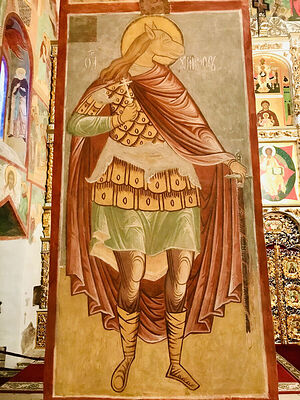 The Dormition of the Mother of God monastery is the symbol of the revival of Sviyazhsk (founded in 1555). If you go from the Trinity Church towards the landing place, a white-stone monastery will greet you behind a turn—all of it, in its full glory. This is how Moscow’s Kremlin once looked. At least this is the first thought that comes to mind.
The Dormition of the Mother of God monastery is the symbol of the revival of Sviyazhsk (founded in 1555). If you go from the Trinity Church towards the landing place, a white-stone monastery will greet you behind a turn—all of it, in its full glory. This is how Moscow’s Kremlin once looked. At least this is the first thought that comes to mind.
After his conquest of Kazan, Ivan the Terrible sent a team of artisans from Pskov with the architect Postnik Yakovlev (who also built the St. Basil’s Cathedral on Red Square) at its head, to build the Sviyazhsk monastery. It means that the Tsar hadn’t changed his thoughts about Sviyazhsk, as if conceiving this island’s fate as a frontier of Holy Rus.
Quite possibly, this is why we see Ivan the Terrible on one of the frescoes in the beautiful and majestic Dormition Cathedral. It is the life portrait of the Tsar.
All frescoes in this cathedral, the subject of thorough studies over the past centuries, are extraordinary, but no one can confirm who was that wondrous icon painter who was able to create these masterpieces to equal or even surpass the medieval treasures in Europe in execution and thought.
But we know that, most likely, the icon painter wasn’t even thinking about such comparisons, or much less, his own greatness, as his job was to reproduce the events of the Gospel and transform the walls into a tutorial about the living faith. He definitely achieved it.
The Dormition Cathedral has a truly uncommon fresco of horse-headed St. Christopher. He is also known as the Cynocephalus. The saint was depicted this way in Rus during the Middle Ages, but later such depictions were removed practically everywhere. The fresco of the saint in Sviyazhsk survived only because it was concealed by the back panel of the tomb holding the relics of the holy hierarch Herman, the Bishop of Kazan. He was the first abbot of the monastery in Sviyazhsk and the first enlightener of all those lands added to Russia by Ivan IV. The Urals and Siberia received icons and books sent from the monastery’s Dormition Church, as well as their first knowledge of Christian teaching. According to tradition, Herman became a victim of the tsar, who couldn’t forgive the accusations the monk made against him. Still, a fresco of the autocrat has remained on the wall right beside the relics of the saint for the last four and a half centuries—probably, long enough to find reconciliation.
Currently, the relics of the holy hierarch are located in the nearby St. Nicholas Church. Herman’s monastic cell is also there, open for pilgrims.
As for the Dormition Cathedral, it is closed in the wintertime due to its status as a valuable landmark, in addition to being a UNESCO World Heritage Site. My faithful guide Fr. Barsanuphius was able to offer a short tour around it. I was later allowed to stay alone in this church and feel how my soul trembled as I stood before the ancient frescoes gracing the holy walls; the wind behind them was the only reminder that I was still here on Earth.
Five churches in five years
Only a handful of monastics reside in the monastery, but none of them are random people. Abbot Simeon (Kulagin) directs the life in the monastery. Like Fr. Barsanuphius, he arrived here from the Optina Pustyn monastery in December of 2016, when the wind was still blowing around the construction scaffolding that surrounded the fortress walls and the churches.
Fr. Simeon, one of those we call, “intellectual monastics,” has been a member of the Church since early childhood, but he didn’t come because of his parents—he came there voluntarily. He has a degree in history and had a successful start in an academic career in sciences behind him. However, he traded his career and all the riches of secular life for the lifelong journey of a monk. Having once arrived to the best, in his opinion, monastery in Russia—Optina Monastery—he couldn’t turn back and return to the world.
Nowadays, Fr. Simeon is transforming the Dormition monastery into a place that you have hard time parting with—one that you long to visit again. Or, quite possibly, stay for good.
“During the first five years of my stay here, we consecrated five restored churches. Can you imagine that level of happiness? I am thankful to God for this experience,” says Fr. Simeon and his kind eyes lit up with joy.
Truly, it is quite an unprecedented case in modern history.
But, for accuracy’s sake, we have to point out that when Fr. Simeon arrived in Sviyazhsk, all the restoration work was in full swing and all that was left to do was to probe deep into this complicated process and sign the certificates of acceptance from the builders of churches and monastery buildings.
As for the one who was able to get things going here and move them forward, we should speak of him separately.
Carried away by the wind
During Soviet times, the Dormition monastery first housed one of the GULAG concentration camps, and later a psychiatric ward. Overall, it was well within the logic of the anti-Christian authorities. But when they, at least officially, made way for those who allowed the opening of a monastery, it turned out that Sviyazhsk was lying in ruins and its residents had long lost any hope for a bright future, with poaching as the only work left to them, in addition to drinking cheap vodka.
The locals have long forgotten how to think about nice things, and it’s still impossible without God anyway. Thus, the ruins lying around. The locals recall today that, in the middle of the 1990s, the island town looked like an exclusion area: abandoned homes, absence of any surfaced roads or walkways, and human remains washing ashore—water, the perennial opponent to the wind, kept bringing back the shards of memory.
And then, a boat came ashore carrying a monk. It was Fr. Kirill Korovin, known afterwards as a consultant to Vladimir Khotinenko, the film director of the movie, “The Priest.” Greeted by some truly sad faces, Fr. Kirill observed his unenviable inheritance. That’s when the story of true asceticism began. Initially, the monk slept right on the ground, went hungry, shoveled the debris, prayed, and tried to come to an agreement with the islanders. He did a lot of talking, and he’s also done a lot for them, because the goal was all too clear for him: He had to change their way of thinking first and only then he could transform their water-locked universe.
Initially, the monk slept on the ground, went hungry, shoveled the debris, prayed, and tried to come to an agreement with the islanders
On top of it all, Fr. Kirill probably had to learn how to befriend that omnipresent dweller of Sviyazhsk. The story of the second Christianization of this particular island even sounds a bit improbable—how allegedly the priest, buzzing around the country and Tatarstan as if carried by the wind, was able to convince both the local authorities and wealthy donors to recognize Sviyazhsk as a historical heritage site and begin the extensive restoration there. Soon afterwards it was connected with the mainland by a road, which delivered stone, wood, and, what’s most important, people to the island.
Once again, the Christian message spread from Sviyazhsk and rushed forward following the sounds of ringing bells, sanctifying the villages and towns that were slowly awakening after the trance of the communist era and the stormy years of perestroika.
This tiny island, permanently inhabited by less than three hundred people including the monastics, suddenly became the “in” place, and the number of visitors to it could probably only be compared to those of select few provincial holy sites like Optina Monastery or the Holy Trinity-St. Sergius Lavra, whose monks previously sanctified this land with their prayers.
Truly, their prayers were very powerful.
Much more powerful than the crafty designs of the enemy or internal strife.
The monks from Sviyazhsk have been wandering around the island for the past five hundred years, saying these prayers, remembering the dead and blessing those who are still living. Those prayers immerse the island’s guests in an atmosphere imbued with a sense of eternity and call upon Him Who, according to the Psalter’s immortal words, not only supporteth his chambers in the waters, but also walketh upon the wings of the wind.

